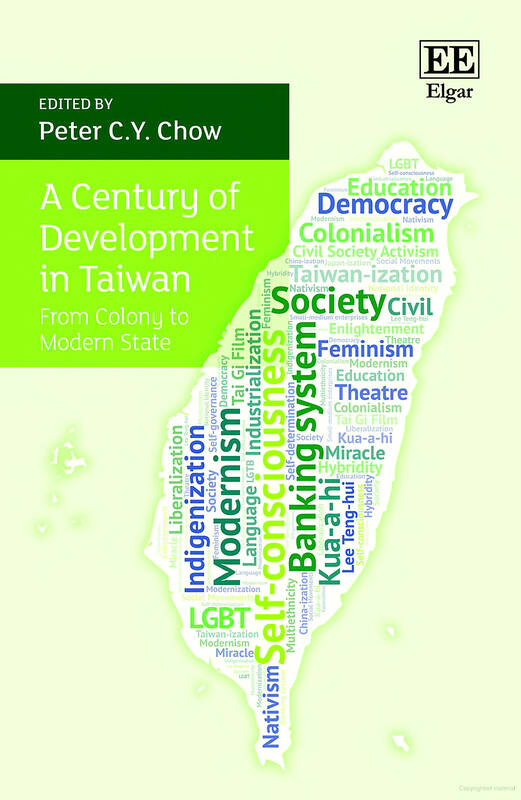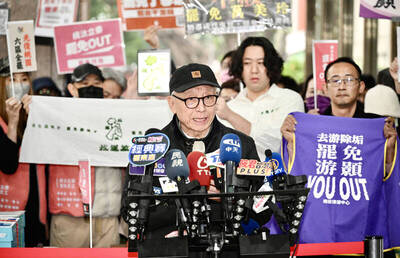It’s no fun beginning a review with an extended whinge; but it’s not often that an academic work is so plagued with errors as to make one wince and mutter in exasperation within the first few pages.
Many are basic grammatical mistakes — some commonplace enough to be stereotypical of non-native English speakers: unnecessary definite articles, confused past-tense forms, causative verbs followed by to-infinitives.
Others involve unnatural constructions that translation software would struggle to mangle so spectacularly. Idiomatic usage is also often askew: In an otherwise excellent discussion of Taiwan’s sovereignty, which spotlights three crucial years — 1951, 1971 and 1991 — Chen Yi-shen (陳儀深) writes that “the KMT’s [Chinese Nationalist Party] waishengren bigwigs, and the party-state throwback would all go down in history.” The phrase, which is intended to convey a pejorative meaning, achieves almost the opposite effect.

Then there are the glaring inconsistencies — Chinese nomenclature and terminology rendered in different ways, often within quick succession. To take an early example: the Petition Movement for the Establishment of a Taiwanese Parliament (臺灣議會設置請願運動), as it is most commonly known in English, is initially referred to as such in a foreword by Waseda University professor Masahiro Wakabayashi, an expert on cross-strait relations. Yet, two pages later it’s the “Petition of Establishing a Taiwan Parliament” (complete with quotation marks) before reverting to the original, a further two pages on, in the book’s introduction by Peter C.Y. Chow (周鉅原), the book’s editor.
By page eight of that same introduction, it has become a mish-mash of lower and upper-casing: the petition of establishment of Taiwan Parliament movement, with prepositions and articles discarded. Finally, in chapter nine, where Academia Sinica sociologist Hsin-huang Michael Hsiao (蕭新煌) provides a history of Taiwan’s civil society movements, we get the Taiwan Assembly Petition Movement. It’s a horrendous muddle.
On top of these more superficial issues, several errors cause such confusion that one has to reread the text several times for clarification.
In Chow’s introductory overview of Taiwan’s development path, for instance, we are told that “this book offers a critical review of the evolution of socio-cultural, economic and national identity in the past century in Taiwan.” Chow, an economics professor at the City University of New York, then informs the reader that “it,” which given its immediate antecedence can only mean “this book,” will be split into four sections. As the book is, in fact, divided into five parts, none of which correspond to the titles of the four sections Chow mentions, the reader is left bewildered. However, closer inspection reveals that these are headings for the sections of Chow’s own chapter, rather than the book itself.
BROADER EXPOSITIONS
If all of this makes for a painfully dull and drawn-out introduction to a book review, I can only say I felt obliged to make things plain: aside from a select few chapters, this book was crying out for a half-decent proof. It’s obvious that some chapters were subjected to far greater scrutiny than others, and the result is, frankly, an embarrassingly uneven mess. More’s the pity, as this is an important collection on a diverse range of themes, featuring refreshingly original scholarship.
At first glance, topics, such as the evolution of banking, which is traced by Hong-jen Abraham Lin (林宏任) in chapter five; and the hybrid of Chinese, Western and Japanese theater performance that became known as opeila — analyzed by Jasmine Yu-hsing Chen (陳幼馨) — might appear too niche or recondite for the average reader. Yet, as with most of the movements, cultural phenomena, sectors and spheres tackled in this book, these two subjects are tools for expositions of broader social trends.
In the first case, currency and banks are used to explore Taiwanese identity and sovereignty. Under Ming Dynasty loyalist and military commander Koxinga, also known as Cheng Cheng-kung (鄭成功), Mexican and Spanish silver coins circulated in Taiwan, which Lin argues, with more than a hint of an agenda, “coincides with the reality of the political autonomy of Taiwan.”
HIDING IN PLAIN SIGHT
At the end of World War II, there were seven banks in Taiwan — three of them featuring the word “Taiwan,” and one a Taiwanese location (Changhua). Yet, by 1979, “when the ideology of the nationalist ROC in the field of banking … reached its peak,” the names of eight of fourteen banks in Taiwan referenced China, following the KMT policy of transferring financial institutions from the “mainland” for political, rather than economic purposes. In the late 1980s, a period Lin dubs Banking 3.0, this Sinicization was reversed, as banks, which had proliferated after the advent of private capital in the early 1990s, embraced Taiwan-centric nomenclature or neutral names.
As for Chen’s treatment of opeila, a phonetic adaptation of the Hoklo oo-phiat-a (胡撇仔) — itself derived from the Japanese pronunciation of “opera” — recollections by former actors that “performances under the Japanization policy were like a stowaway’s game” make for a fascinating read. With Hoklo-language performances banned at the outbreak of the Second Sino-Japanese War, opeila troupes would post lookouts at theater entrances to warn of approaching police patrols. Actors would then quickly switch to Japanese costume and language until the inspectors — satisfied that the production was suitably patriotic — moved on.
LIMITED KNOW-HOW
In addition to these tidbits, strong revisionist arguments are found throughout the book — particularly against received (KMT-promoted) wisdom regarding Taiwan’s postwar industrial and economic development. In chapter seven, Chow gainsays the idea that the KMT single-handedly fostered Taiwan’s small and medium enterprise success, asserting that pioneering SMEs originated in tandem with military-related industries in the 1930s.
Meanwhile, in chapter six, Frank T. Hsiao (蕭聖鐵) notes that the KMT’s vaunted import substitution policy had a precursor in wartime Japan’s efforts to foster self-sufficiency, with Taiwan experiencing “miracle growth” in this period. While allied raids “destroyed almost half of the industrial facilities in Taiwan,” Hsiao observes that, by the end of the war, Taiwan was still streets ahead of China in many regards. The 22 electric plants operated by the National Resources Council (NRC) in China, for example, generated a paltry 4 percent of the power provided by TaiPower; and while all but two of the Chinese plants used coal, most of Taiwan’s electricity generation was "hydraulic" [sic]. One result of this was that “the experience and ability of the KMT technocrats was extremely limited.”
All of this, and a good deal more, make the information in this collection valuable to anyone wanting to know how Taiwan got to where it is today. It’s just a shame the presentation falls so far short of the content.

The Democratic Progressive Party (DPP), Chinese Nationalist Party (KMT), and the country’s other political groups dare not offend religious groups, says Chen Lih-ming (陳立民), founder of the Taiwan Anti-Religion Alliance (台灣反宗教者聯盟). “It’s the same in other democracies, of course, but because political struggles in Taiwan are extraordinarily fierce, you’ll see candidates visiting several temples each day ahead of elections. That adds impetus to religion here,” says the retired college lecturer. In Japan’s most recent election, the Liberal Democratic Party lost many votes because of its ties to the Unification Church (“the Moonies”). Chen contrasts the progress made by anti-religion movements in

Taiwan doesn’t have a lot of railways, but its network has plenty of history. The government-owned entity that last year became the Taiwan Railway Corp (TRC) has been operating trains since 1891. During the 1895-1945 period of Japanese rule, the colonial government made huge investments in rail infrastructure. The northern port city of Keelung was connected to Kaohsiung in the south. New lines appeared in Pingtung, Yilan and the Hualien-Taitung region. Railway enthusiasts exploring Taiwan will find plenty to amuse themselves. Taipei will soon gain its second rail-themed museum. Elsewhere there’s a number of endearing branch lines and rolling-stock collections, some

Last week the State Department made several small changes to its Web information on Taiwan. First, it removed a statement saying that the US “does not support Taiwan independence.” The current statement now reads: “We oppose any unilateral changes to the status quo from either side. We expect cross-strait differences to be resolved by peaceful means, free from coercion, in a manner acceptable to the people on both sides of the Strait.” In 2022 the administration of Joe Biden also removed that verbiage, but after a month of pressure from the People’s Republic of China (PRC), reinstated it. The American

This was not supposed to be an election year. The local media is billing it as the “2025 great recall era” (2025大罷免時代) or the “2025 great recall wave” (2025大罷免潮), with many now just shortening it to “great recall.” As of this writing the number of campaigns that have submitted the requisite one percent of eligible voters signatures in legislative districts is 51 — 35 targeting Chinese Nationalist Party (KMT) caucus lawmakers and 16 targeting Democratic Progressive Party (DPP) lawmakers. The pan-green side has more as they started earlier. Many recall campaigns are billing themselves as “Winter Bluebirds” after the “Bluebird Action”